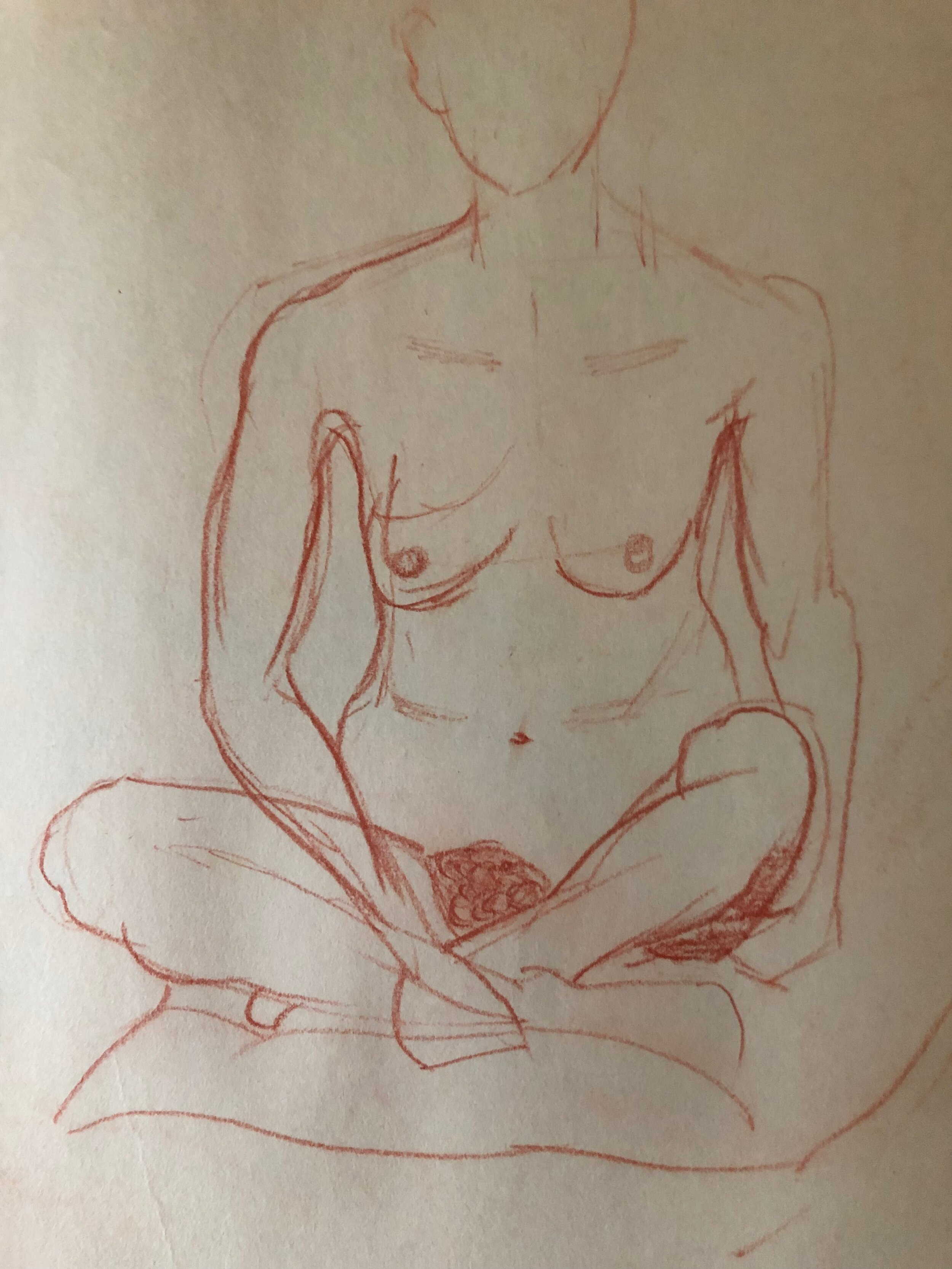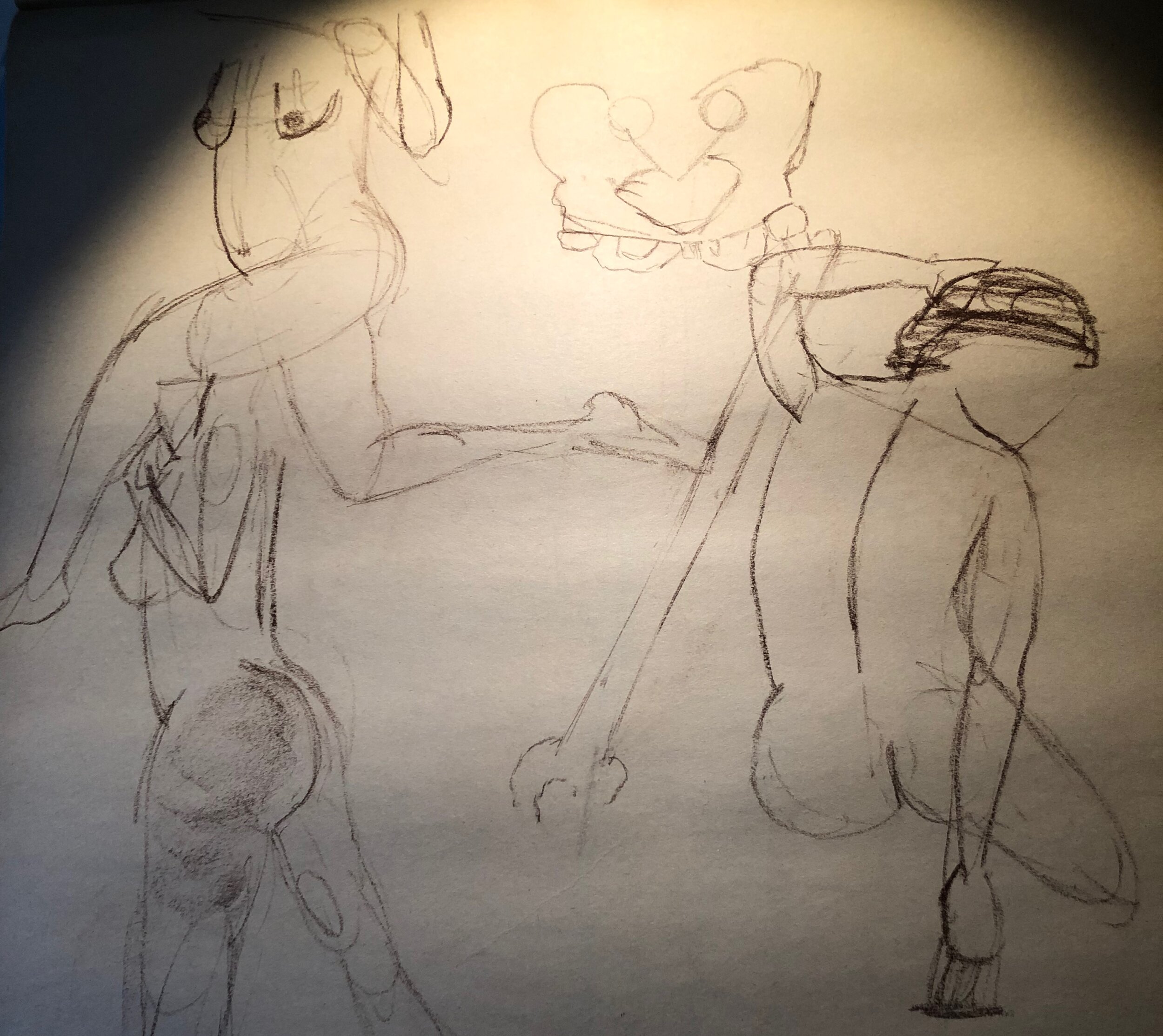How art school changed me.
My self portrait on a 30” figure sculpture. Handmade in multiple stages over the course of 9 months in 1992-93 in New Orleans; photographed in the rain today in my front yard where it is now growing moss, August 15, 2021.
Colors, textures, objects, places, spaces. Seeking meaning in the world. Making my Mark: 1989-1993.
After finishing college, even though I had the odd luck of getting hired onto salary out of an internship, I longed to be a more radical changemaker in the world. I cherished the work my mother did as an artist, but I was never brave enough to pick up a pencil. To me, part of being a feminist is conquering fears head-on. One night-class adventure in figure sculpture turned into a serious commitment to study and to apply my art to other places in my life.
Embodying My Heritage, Embracing the Unknowable
Two Minute Sketches, Life Drawing class, probably from my final semester. I kept one of my drawing tablets from Life Drawing at the New Orleans Academy of Fine Art; found this tablet today in the garage and brushed off the cobwebs.
I lived in France for my junior year in college, 1986-87, so that I could be immersed in the language and culture of my ancestors. That scary experience of letting go of English as the dominant language in my body was deep. Similarly in art school, I learned and unlearned other languages and modes of interpreting. I recognized over and over the unknowable in reality. And I surrendered, best I could, to mimic the methods and respect and tolerate the personalities of teachers, breathing into a sense of oneness with the clay, charcoal, and the figure in space.
Out of sheer practice and curiosity, I gradually overcame an abject fear of drawing and slowly grew beyond absolute beginner status. It was actually a kind of spiritual challenge for me.
Life drawing sketch, maybe a 10 minute pose, choosing when to press into space or go lightly, emily cox.
For hundreds of hours, many of them solitary, in the big old Art Academy house on Magazine Street, I sat, stood or watched, listened, and practiced learning to re-interpret reality. The New Orleans Academy of Fine Arts was always a safe space for me and it was strikingly quiet and respectful in climate most of the time. My classmates were made up of mostly older folks, artists, more women than men. I bonded with people 10-30 years my senior; we were sharing a tough path. We were proud our school was both woman-owned and managed, and it made a real difference compared to other schools and workplaces. There were times when we needed studio access, a make-up class, or some flexibility for late payment. And whether it was to support us or to help us feel secure in a problematic situation with a teacher, the management had the students’ backs.
Life drawing sketch, the use of sweeping action, emily cox.
Come to think of it: This was the third big choice in my life that provided grounds for me to prove to myself my value as a creative, fear-conquering person—my junior year in France (1986-87), working for the French government (‘87-91) and learning sculpture and drawing (‘89-92).
I wanted to be openly courageous, gain meaningful skills and also, I was determined to shake the world’s view that as a girl I was fated to a life of second-class citizenship–powerless in a contemporary society that uses oppression and bureaucracy to sabotage humanism and transparency.
Two Great Literary Sign Posts
Racism, sexism and the Christian right were dispiriting themes in my French-Louisiana life. Art, music, and literature were my refuge. Zora Neale Hurston became my literary hero.
Her ability to paint a picture, to translate feelings, conversations, dialects and the weather through story moved my soul. “Their Eyes Were Watching God” was my favorite novel, alongside “The Moviegoer” by Walker Percy.
The narration of “Their Eyes” felt personal, authentic and urgent to me at the time. To this day, I believe Zora Neale Hurston’s stories need more and more eyes and ears. Visual art, literature, poetry, spoken word, music, the performing arts, in these spaces we experience the depths of joy and sorrow in ways that transcend rational language. The new 75th anniversary edition is a favorite graduation gift of mine. Someday I plan to go to the Zora Neale Hurston Festival in her hometown of Sarasota, Florida.
While I was studying art, Walter Anderson and his family story served as an artist-family inspiration too.
Anderson struggled with mental illness and poor health care and mistreatment by the medical system. He was driven by a love of nature so deep that he would go to extremes to communicate with it. His grandson, a kind and gentle and gifted soul, was one of those students sitting next to me in class; and we shared a passion for the experience of just being in class and doing the work. Anderson’s wife’s book remains one of my favorite books to this day. Agnes Grinstead Anderson. Approaching the Magic Hour. Memories of Walter Anderson Jackson and London: University Press of Mississippi, 1989.
If you are near New Orleans, be sure to go to Ocean Springs to pay the Anderson family your respects and see whatever art, museums, potteries, galleries have survived Hurricane Katrina.
Experimentalism as Spiritual Practice
In my focused study time, I built an internal connection to the world of perception and the mystery of interpreting positive-negative space, light-darkness, additive-subtractive materials. Sitting with nude figures for hours in near-silence, working with earth, with charcoal, with water, and pigment. Experimentalism was essential in my mind, since early childhood. I was a heretic throughout my time in Catholic high school, and at the Jesuit university of Loyola. I was on an exploratory path to find my own language and my own way to the truth.
Life drawing sketches 1 and 2, how to show the synergy in crossing limbs, emily cox.
In the second year, I recognized a feeling of being “in my water” as an art student. Around this time I decided that the quiet, the structure, and sense of adventure was such a good fit for me–“I will never stop being a student.” None of the courses came easily; clay sculpture was my preferred medium, but I struggled with drawing and painting. Even so, I was pulled in to go deeper, and after a few semesters at the Academy, I decreased my full-time work hours to a part-time schedule. The school director had tapped me for a scholarship, so my courses were suddenly free of charge. What an encouragement!
Life Drawing sketch, turn the crayon on its side for texture and movement, emily cox.
With clay and crayon I honed my insight into finding ways to make life more meaningful, valuable, peaceable. The key seemed to be to slow down. To look more carefully. To be open to being wrong. To be surprised. Often. And recalibrate. This process, much like the shedding of my American-skin studying and traveling in Europe, directly informed my future work-life experiences.
Life drawing, 1 and 2, exploring depth of space and foreshortening, emily cox.
While I was feeling more and more at ease in my spirit, in the face of the impossible, how could I live and work as a white woman of privilege, I struggled? I was bound for a future as a wife and mother and service work, by choice. Where could I find a creative place to work outside the tradition of “art teacher,” or as the perpetual “assistant” to other people’s dream projects? I wanted to change the way communities perpetuated white male-dominated, violence-dominated culture over creative, more multicultural, socially equitable culture. I would never seek to earn a lot of money, but I would not be content being treated as a second-class citizen either.
What I wanted in my personal life was to find a work-life balance. To work to build peace. To create welcoming space. For study and play, where young people could access and form their own identities and make a mark without capitalism at the center. I found in my final 6 months in New Orleans, with an apprentice job with the founder/artist of YA/YA, Inc, a chance to play an unforgettable role in art activism. We were connecting young artists to their work aspirations.
Peace in studio zone, War all around us
As an art student, I sought to integrate my interior spiritual journey with my physical experiences with different media—I wondered how can I explore with a wide-open mind without fear or judgment? That was my goal.
Life drawing, three poses, emily cox.
The experiences with curves in space, with figures that cannot stand still that were being converted into different materials signified, for me, an experiment with reality. I was in a sacred space. Making a mark was mutable in many ways in an art studio.
Outside the mostly-peaceful studio time, David Duke, the Grand Wizard of the Ku Klux Klan, was running for governor of Louisiana. On October 6, 1990 I hired a limo driver to take me and my new husband from our wedding reception to the little polling place in a garden district garage, so that we could vote for the sleezy, crooked Democrat, Edwin Edwards (and Bill Clinton, over George Bush). What a sick world.
There was never one right path and I was and still am a perpetual student. I had found a form of practice in art school, in my early 20s, where I actively rejected the hierarchical, dualistic, binary culture through a sort of art-meditation. Starting in early childhood I knew I was different. I could not go along. I was an observer and an analytical thinker. And the fundamental ways the world worked were upside down.
Personal Identity Struggle
My quiet, determined focus on art, spaces, texture, and lines was expanding my field of vision for my inner self. I was growing in creative strength and changing, but how?
To this day, I continue to struggle with the conundrum, “Who am I? Do I have the capacity to make an impact on the community for change?”
Through this rigorous and humbling process, I experienced, in a visual and tactile way, how deeply we are all wholly human, regardless of any attack on our dignity or humanity.
Creative and imaginative exploratory processes offer the kind of force that can gather people to work for peace across age, race, culture, and faith. Creativity and imagination are keys to freedom.
The End.

























